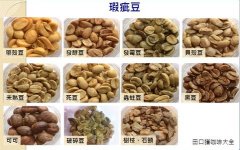Fine coffee bean basic coffee bean grinding terminology
Caffeine: Caffeine is the most noticeable of all coffee ingredients. It belongs to a kind of plant xanthine (animal muscle component). Its nature is the same as theobromine contained in cocoa. The theophylline contained in green tea is the same. After baking, the percentage of reduction is extremely small. The effect of caffeine is extremely extensive, which will affect various parts of the human brain, heart, blood vessels, gastrointestinal tract, muscles and kidneys. An appropriate amount of caffeine will stimulate the cerebral cortex, promote sensory judgment, memory and emotional activities, make the myocardial function more active, expand blood vessels and enhance blood circulation. And improve metabolic function, caffeine can also reduce muscle fatigue, promote digestive juice secretion. In addition to this, because it also promotes kidney function to help the body expel excess sodium ions (chemical components that hinder water molecule metabolism), caffeine will not accumulate in the body like other narcotic and excitatory substances (narcotic drugs, paint solvents, stimulants, etc.), and will be excreted in about two hours. Coffee flavor in the biggest special burn-bitter, is caused by caffeine.
Tannin acid: After extraction, tannin acid will become pale yellow powder, which is easy to blend into water. After boiling, it will decompose and produce pyrochloric acid, which will make coffee taste worse. If brewed well and put on for several hours, coffee color will become thicker than just brewed, and it will not taste enough, so there will be a saying that "brewed well, it is best to drink it as soon as possible."
Fat: Coffee contains fat, which plays an extremely important role in flavor. Analysis shows that coffee contains fat divided into many kinds, and the most important of them are acidic fat and volatile fat. Acidic fat refers to fat containing acid. Its strength will vary according to different types of coffee. Volatile fat is the main source of coffee aroma. Roasted coffee beans contain fat that, once exposed to air, undergoes biochemical changes that degrade flavor and aroma.
Protein: The main source of caroli is protein, and like coffee brewed by dripping, most of the protein will not dissolve out, so the nutrition obtained by coffee drinking is also limited, that is, coffee will become the reason for weight loss.
It is said that Beethoven grinds 60 coffee beans every morning and then brews coffee while grinding coffee and enjoying its aroma. Then enjoy it with gusto. Coffee beans grinding methods can be slightly divided into coarse grinding, medium grinding and fine grinding according to their size. Use appropriate grinding methods depending on coffee equipment. There is also a medium fine grind or a very fine grind finer than fine grind (into powdered coffee powder). And coffee beans grinding time is brewing coffee before, only the need to grind that is the top grade. Coffee beans are ground into powder and their surface area increases to absorb moisture and oxidize easily. In short, with the passage of time, coffee powder also plays a role in the deterioration of flavor damage. Also, after the ground coffee beans are placed, the carbon dioxide and aroma retained in the beans will be lost together. In this way, the coffee powder should expand and not expand when extracted and filtered, and no matter how it is, it cannot make delicious coffee. And the secret is to consider grinding consistently with the job, so that brewed coffee is the most delicious and mellow.
Fine grind
◎ Fine grinding (fine particles, the same size as sugar)
Medium grind
◎ Medium grind (grain size like sugar mixed with coarse sugar)
Regular grind
◎ Rough grinding (coarse particles, the same size as coarse sugar)
Important Notice :
前街咖啡 FrontStreet Coffee has moved to new addredd:
FrontStreet Coffee Address: 315,Donghua East Road,GuangZhou
Tel:020 38364473
- Prev

Introduction to Coffee basic knowledge, Fine Coffee and defective beans
Moldy beans: because of incomplete drying, or damp in the process of transportation and storage, cyan and white molds grow, which sometimes make the beans stick together. If these moldy beans are not removed, they will produce moldy smell. Dead beans: beans with abnormal results. The color is not easy to change because of baking, so it is easy to distinguish. The flavor is thin, as harmful as silver skin, and will become a peculiar smell.
- Next

Introduction to the origin of boutique coffee beans Salvadoran coffee
Salvadoran coffee ranks side by side with Mexico and Guatemala as the producers of Asa and Merdo, and is fighting for the top one or two places in China and the United States with other countries. The highlands of origin are large coffee beans of all sizes, which are fragrant and mild in taste. Like Guatemala and Costa Rica, coffee in El Salvador is graded according to altitude, and the higher the altitude, the better the coffee
Related
- Guji coffee producing area of Guji, Ethiopia: Humbela, Shakiso, Wulaga
- What is the most expensive variety of Qiloso in BOP multi-variety group?
- How to store the coffee beans bought home?
- Why are Yemeni coffee beans so rare now?
- Ethiopian Sidamo all Red Fruit Sun Sun Santa Vini Coffee beans
- SOE is mostly sour? What does it mean? Is it a single bean? what's the difference between it and Italian blending?
- Is Italian coffee beans suitable for making hand-brewed coffee?
- How to choose coffee beans when making cold coffee? What kind of coffee beans are suitable for making cold coffee?
- Just entered the pit to make coffee, what kind of coffee beans should be chosen?
- Can only Japan buy real Blue Mountain Coffee? What are authentic Jamaican Blue Mountain coffee beans?

